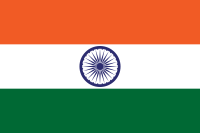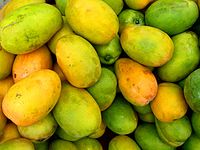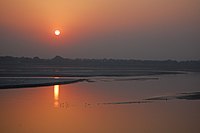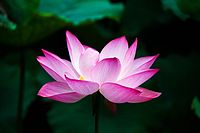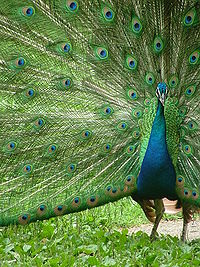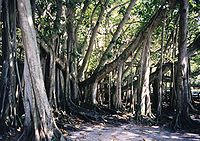|
|
It took some time for the boundaries of the proposed new state of Rajasthan to be defined. In 1948, Rajasthan comprised the south and south-eastern states of Rajputana. With the merger of Mewar, Udaipur became the capital of the United State of Rajasthan. The Maharana of Udaipur was invested with the title of rajpramukh (head of state). Manikya Lal Varma was appointed as prime minister of the new state, which was inaugurated on 18 April 1948. The kingdoms of Bikaner, Jodhpur, Jaisalmer and Jaipur were merged in 1949. The Maharaja of Jaipur, Man Singh II, was invested with the title of rajpramukh. Jaipur became the capital of the new state of Rajasthan. Heera Lal Shastri was installed as the first premier of Rajasthan. Later in 1949, the United States of Matsya, comprising the former kingdoms of Bharatpur, Alwar, Karauli and Dholpur, was incorporated into Rajasthan. As a consequence, Rajasthan became the second largest state in India, exceeded in geographical area only by the central Indian state of Madhya Pradesh. Rajasthan attained its current dimensions in November 1956 with the additions of Ajmer-Merwara, Abu Rd and a part of Dilwara, originally part of the princely kingdom of Sirohi which had been divided between Gujarat and Rajasthan. The princes of the former kingdoms were constitutionally granted handsome remuneration in the form of privy purses to assist them in the discharge of their financial obligations (and to keep them in the style to which they had become accustomed). In1970, Indira Gandhi who had come to power in 1966, commenced under-takings to discontinue the privy purses, which were abolished in 1971.
The national emblem of Rajasthan is a logo. It shows the outline of the map of Rajasthan, the Asoka capital and the title ‘Government of Rajasthan’ in white rendering on a blue background.
|
> Rajasthan Police <
|
In the formative years, Rajasthan Policce had to face a host of organisational and operational problems. The initial years were spent in organizing and introducing a uniform system that would be applicable to the whole of Rajasthan.
The entire force was divided into two distinct cadres: the Civil Police and the Armed Police.
The first Prime Minister of India. Shri Jawahar Lal Nehru presented colours to Rajasthan Police on 30 March, 1954. This consisted of a dark-blue flag with an emblem of a landscape with a palm-tree between a camel and a horse, surrounded by a garland and crested with the Asola capital.
New colours were presented by the Governor of Rajasthan on 17 April 1992.
|
Jaya Stambh
|
The new emblem of Rajasthan Police consists of the Jaya Stambh or Victory Tower of Chittaorgarh between two swords in saltire and a shield charged with four shells (?) 1, 2 and 1, crested with the Asoka Capital with its motto, being the emblem of India. Below is the name of the service: Rajasthan Police:
rajSqan puils
The emblem is surrounded by a garland and a ribbon below charged with a star and the motto: Sevarth Katibaddhta / Committed to Serve:
syvwQé kidbÛqw
The Jaya Stambh, or Tower of Victory was erected by Rana Kumbha to commemorate his victory over Mahmud Khilji of Malwa in 1440. The tower was constructed between 1458 and 1488. It rises 37 metres in nine storeys and there are narrow stairs to the top. The whole tower is covered with intricate sculptures depicting the story of Ramayana and Mahabharata
The local services of Rajasthan Police bear this emblem in white rendering on a disc parted per bend sinister Gules and Azure.
|
|
Rajasthan Police Emblem ancient
|
Rajasthan Police Emblem new
|
Princely States
|
|
Alwar
|
Maharao Raja Pratap Singh laid the foundation of this State in 1725 with Alwar as its capital. The ruling family belongs to the Naruka sub-clan of Kachhwa Rajputs.
|
Sheodan Singhji
|
Maharao Raja 1857 - 1874
|
.
Arms: Barry of five Gules, Vert, Argent, Azure and Or, between four kutars in saltire, hilted Or, a tower on a crag proper.
Crest: On a helmet to the dexter, lambrequined Gules and Or, a hand holding in bend sinister a branch of a kuchnar-tree.
Supporters: A sambur (Rusa unicolor - Cervidæ) and a tiger (Panthera tigris - Felidæ).
Motto: GADH JITE SAV DHAP
(Taylor 90)
|
Mangal Singhji
Jai Singhji
Tej Singhji
|
Maharaja 1874 - 1892
Maharaja 1892 - 1937
Maharaja 1937 - [2009]
|
In a letter to the Government of India Maharaja Mangal Singhji discarded Taylor’s design and gave his reasons why he substituted his own. Taylor had four kutars in a very unheraldic layout with the Panchranga barry of the field. Item by item the Maharaja eliminates everything, and leaves just Azure, a Kutar erect Or on a round shield.
The solitary kutar recalls the following story. Mairaj, the father of Naru, the founder of the Narukha clan, was at war with Kalodar Jhala of Jhalrapatan. Arriving at an impasse, the combatants had a conference, the chiefs squatting on the ground opposite each other, when four of Jhala’s men seized Mairaj’s arms from behinmd.
Being unable to use his hands, Mairaj dashed his foot into the square-handed grip of the kutar in Jhala’s cummerbund and with a vigorous kick, plunged it into his stomach. [2]
Arms: Azure, bossed and a kutar per pale, within a bordure, voided of the field and ornamented with acanthus-leaves Or.
Crown: The royal crown of Alwar.
Supporters: Two national flags, being barry of Gules, Vert, Argent, Azure and Or in saltire and on the dexter a bull and on the sinister a tiger.
Compartment: A grassy ground, porper
Motto: ATMANAM SATATAM VIDDHI (Always know yourself) in white lettering on a purple ribbon.
(Jaipur)
The original design is in the Jaipur Central Museum.
Alwar stamps of ¼ and 1 anna (1877) and of ¼ anna (1899-1901), showing the single kutar.
|
Banswara
|
Maharawuls of Banswara
|
Lakshman Singh
Shumbhu Singhji
Prithvi Singhji
Chandraveer Singhji
|
1844-1905
1905-1913
1913-1944
1944-1985
|
Arms: Gules, two chevronels Ermine within a bordure Or, and a cantgon also Gules, a sun in splendour Or.
Crest: On a helmet to the dexter, lambrequined Gules and Argent, a demi-lion proper, holding a trident Azure.
Supporters: A bull and a horse.
Motto: MITHYA PAPAYOR GHRNAM KURU. (One devoted to duty is ever victorious)
(Taylor, 5)
The Durbar flag is red with a yellow border founded by Jagmal (1581 A.D.), conquered from a Bhil named Wasna. The family god is Mahadeo (Siva), hence the bull and the trident, but the special patron or kuldevi is Metaji Sinhaivasniji represented as seated on a lion. She commanded Rawi Augur Singh in a vision to take her away from the Gossain sect and adopt her as his Kuldevi. He obeyed her command (1595 A.D.) and prospered greatly under her favour. [3]
|
Bharatpur
|
The Rulers of Bharatpur State are Jats of the Sinsinwar clan. The clan assumed this name after their original home village Sinsini. The family traces back its ancestry to the 11th Century.
Bharatpur was the first state in Rajputana to make an alliance with the British in 1803.
Maharajas of Bharatpur
|
Jaswant Singhji
Ram Singhji
Kishan Singhji
Brijendra Singhji
|
1853-1893
1893-1900
1900-1929
1929-1995
|
A photograph, today in the Victoria and Albert museum, of the durbar of Jaswant Singhji 1862 shows a banner behind the ruler consisting of a central piece charged, amongst others with three suns radiant, within a wide bordure strewn with stars and with eight crescents. On his right side there is courtier holding up a pear-shaped screen charged with a faced sun radiant. On his right side an ensign holds the standard. No colours of these magnificent regalia are known. [4] |
For the durbar of Delhi in 1877 Jaswant Singji was granted an achievement western style:
Maharaja of ....
Arms: Or, a castle Gules and on a chief Azure a cow statant Argent.
Crest: On a helmet affrontée, lambrequined Or and Gules, an elephant’s head couped.
Supporters: A tiger and an elephant
Motto: SRI LACHMAN JI SAHAY (Lord Lachman Sahay).
(Taylor, 13)
The castle Gules stands for Lohagarh Fort, Bharatpur:
|
Maharaja Brijendra Singhji bore (1943):
Arms: Quarterly: 1. Two kutar in saltire; 2. A cow statant; 3. Fort Lohangar; 4. A cornac or mahout driving his elephant. Below the shield two red pennons in saltire charged with a cannon.
Crest: On a crowned helmet affrontée, a castle (?) flying the pennon of Hanuman.
Supporters: A lion guardant and an elephant both collared with a crown and shackled.
Motto: In chief: PRAJABALAM RAJABALAM RRASASYATAM (Hail to the power of the King and the People). On the ribbon: SRI GOKULENDRA JAYATE (Lord Gokulendra will conquer).
|
Bikaner
|
Maharajas of Bikaner
|
Sardar Singh
Dungar Singh
Ganga Singh
Sadul Singh
|
1851-1872
1872-1887
1887-1943
1943-1950
|
To Dungar Singh was granted:
Arms: Barry of six Gules and Or, three falcons close Argent, each charged with a trident Gules.
Crest: On a helmet affrontée, lambrequined Gules and Or, a green tree.
Supporters: Two leopards Sable.
Motto: JAYA JAIGALDAR BADSAH (Victory to the Emperor Jaigaldar)
(Taylor, 15)
Ganga Singh bore:
Photo HdV 1984
Paintingof the achievement, Bikaner Palace
2. The same, the tridents lacking, the motto changed.
3. On a flag parted per fess yellow and red, today in Jodhpur Museum, the achievement is:
Arms: Or, three bars Azure, Gules and Vert, 3 falcons close Argent on the bars Azure and Vert, 2 and 1.
Crest: On a helmet affrontée, lambrequined Gules and Or, a green tree.
Supporters: Two leopards Argent
Motto: In golden lettering on a ribbon Azure.
|
Bundi
|
Bundi joined the Federation of Rajasthan on 25 March 1948.
Maharajas of Bundi
|
Ram Singh
Raghubir Singh
Isjwari Singh
Bahadur Singh
|
1821-1889
1889-1927
1927-1945
1945-1977
|
Photo NN
A faced sun radiant in Bundi Palace
The figure may have been the ancient emblem of the Mughal Emperors or, later, the emblem of the maharajas of Bundi.
Photo HdV 1984
Fresco in Bundi Palace
|
|
|
Standard and Banner
On a fresco in Bundi Palace, dating from the 16th-17th century and dedicated to the victories of the Maharajas of Bundi, the army of Bundi is depicted.
The standard of Bundi on it is a three pointed cloth of five hoizontal stripes, probably of five different colours like the standards or flags of Jodhpur and Jaipur.
The banners are red and have three points and a yellow edge. They show a sword, a kutar and a shield together with a Buddapada the footprints of the Buddha and a cobra.
|
Ram Singh was granted an achievement western style in 1877:
|






